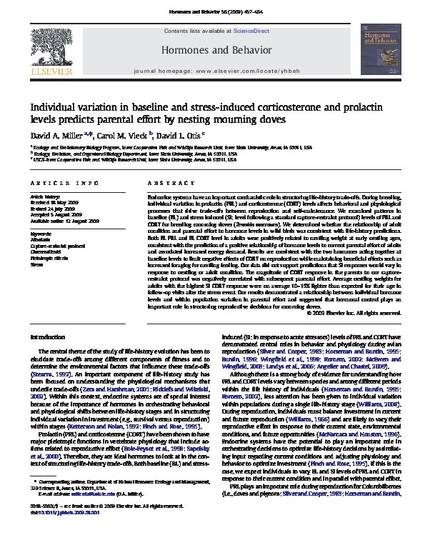
Article
Individual variation in baseline and stress-induced corticosterone and prolactin levels predicts parental effort by nesting mourning doves
Hormones and Behavior
Document Type
Article
Disciplines
Publication Version
Published Version
Publication Date
10-1-2009
DOI
10.1016/j.yhbeh.2009.08.001
Abstract
Endocrine systems have an important mechanistic role in structuring life-history trade-offs. During breeding, individual variation in prolactin (PRL) and corticosterone (CORT) levels affects behavioral and physiological processes that drive trade-offs between reproduction and self-maintenance. We examined patterns in baseline (BL) and stress induced (SI; level following a standard capture-restraint protocol) levels of PRL and CORT for breeding mourning doves (Zenaida macroura). We determined whether the relationship of adult condition and parental effort to hormone levels in wild birds was consistent with life-history predictions. Both BL PRL and BL CORT level in adults were positively related to nestling weight at early nestling ages, consistent with the prediction of a positive relationship of hormone levels to current parental effort of adults and associated increased energy demand. Results are consistent with the two hormones acting together at baseline levels to limit negative effects of CORT on reproduction while maintaining beneficial effects such as increased foraging for nestling feeding. Our data did not support predictions that SI responses would vary in response to nestling or adult condition. The magnitude of CORT response in the parents to our capture-restraint protocol was negatively correlated with subsequent parental effort. Average nestling weights for adults with the highest SI CORT response were on average 10–15% lighter than expected for their age in follow-up visits after the stress event. Our results demonstrated a relationship between individual hormone levels and within population variation in parental effort and suggested that hormonal control plays an important role in structuring reproductive decisions for mourning doves.
Rights
Works produced by employees of the U.S. Government as part of their official duties are not copyrighted within the U.S. The content of this document is not copyrighted.
Language
en
File Format
application/pdf
Citation Information
David A. Miller, Carol M. Vleck and David L. Otis. "Individual variation in baseline and stress-induced corticosterone and prolactin levels predicts parental effort by nesting mourning doves" Hormones and Behavior Vol. 56 Iss. 4 (2009) p. 457 - 464 Available at: http://works.bepress.com/carol-vleck/8/

This article is from Hormones and Behavior 56 (2009); 457, doi: 10.1016/j.yhbeh.2009.08.001.